As an Amazon Associate I earn from qualifying purchases. This website also participates in other affiliate programs and may earn commissions if you shop through the links used on this website.
(This article was originally published on August 6, 2021 and was last updated on September 15, 2022)
Basil flowers are a common occurrence for basil plants, and it can be difficult to prevent them from flowering. However, there are some things you can do to encourage the growth of more basil leaves instead! In this blog post we will talk about why basil plants flower and what gardeners can do to prevent or encourage basil flowers.
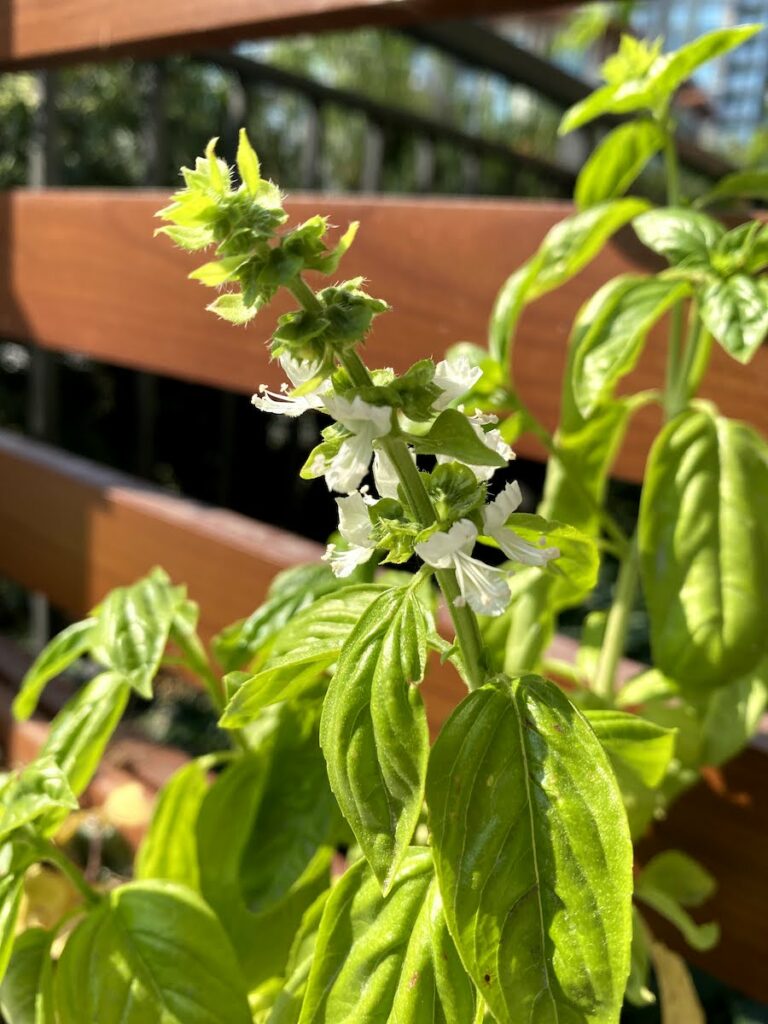
If you’re a beginner herb gardener, you might not have seen basil flowers before.
Indeed, basil is a flowering herb, and at some point over the course of the growing season, don’t be surprised if you’re previously leafy-only basil plant suddenly sprouts little flower buds, and – if you don’t get on top of it right away – rather lovely flowers ranging from purple to white in color.

While a basil plant flowering isn’t the worst thing in the world, I’m afraid to say it means your plant’s life is probably limited once you see the flower buds. The taste becomes bitter, making it not a great choice for cooking, and it’s also no longer suitable for propagating a new basil plant using cuttings, either. (That said, you can definitely throw the flower buds in recipes like vodka infusions or a nice pesto if you catch them quickly and the whole plant hasn’t flowered yet).
More Than 7,000 People Can’t Be Wrong!
For one-off problems with your basil or herb garden, a quick Google to solve the problem is great.
But if you want more help getting the herb garden of your dreams, mastering cooking with basil, or other creative uses of basil, Skillshare has some awesome herb-related courses (plus a ton of other interesting, useful and cool courses).
To date, more than 7,000 students have taken Indoor Gardening: Grow Houseplants, Veggies, and Herbs!
Normally Skillshare Gives A 7-Day Free Trial. You Get A 30-Day Free Trial (OR 30% Off An Annual Membership)
Our friends at Skillshare have graciously offered our readers an extended free trial, using this link here to sign up. Instead of 1 week to try out all their courses, you get a full month to try courses like:
- Indoor Gardening: Grow Houseplants, Veggies, and Herbs // (use this link to get a 30-day Free trial) // (use this link to 30% off an Annual Membership)
- Create a Small Space Edible Garden // (use this link to get a 30-day Free trial) // (use this link to 30% off an Annual Membership)
- 5 Easy to grow herbs, sowing, growing and harvesting // (use this link to get a 30-day Free trial) // (use this link to 30% off an Annual Membership)
- Crafting Infused Tea: Herb, Flower, and Fruit Iced Teas // (use this link to get a 30-day Free trial) // (use this link to 30% off an Annual Membership)
Sign up for a FREE 30-Day Trial (this link only)
Or Save 30% Off An Annual Skillshare Membership
If you know you’re going to love Skillshare, you can also sign up for an annual membership and save 30% with this link.
As annuals, basil plants rarely last more than a year. Sometimes you can get them to last a year or longer if you grow them inside with proper care, but even then it’s not a given. For outside plants in most growing climates in the Unites States, they last even less: for the summer, and gone at first frost.
If your basil flowers, it’s simply following its natural growing cycle, and the flowers will be followed by the plant producing seeds. Once it gets to this point, the leaves are no longer the fragrant, delicious and tender leaves you got previously, and aren’t as suitable for using in the kitchen.
So what can you do about it? If you want to prevent a basil plant flowering and seeding cycle, the secret lies in regular and fairly aggressive pruning and pinching off the flower buds as you spot them.
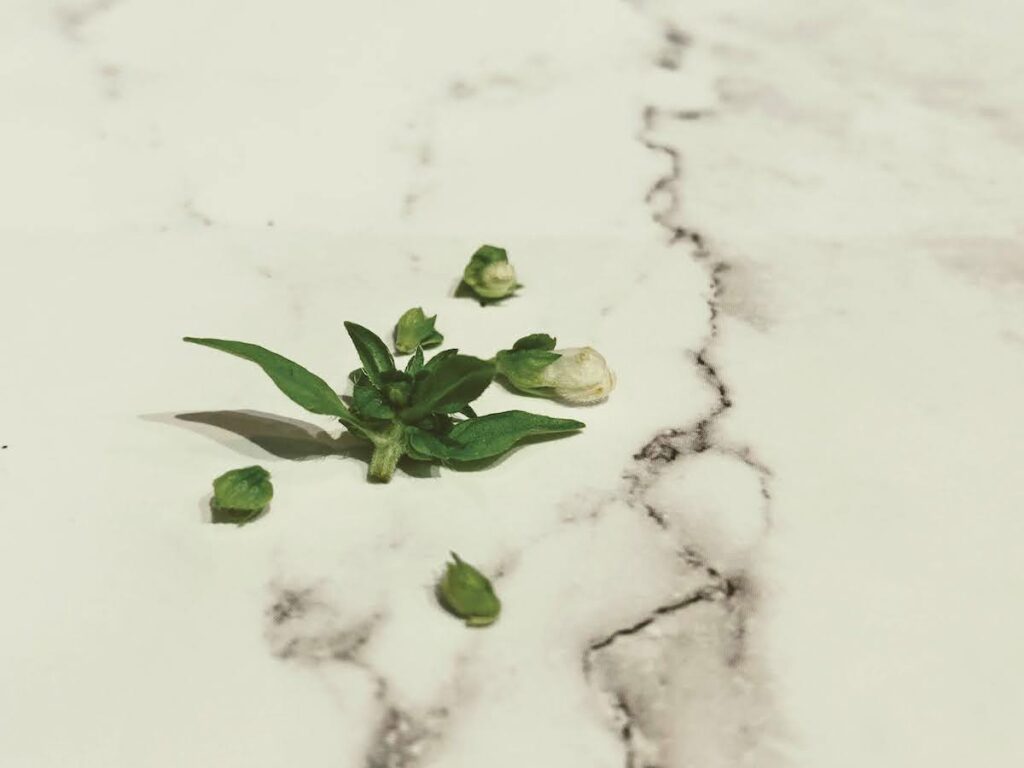
If you’re interested in basil flowers (and how to avoid them) or what to do with a basil plant that’s flowering (and the basil flowers it produces), keep reading for my best tips and advice.
Why Basil Flowers
Simply put, basil is an annual plant, which doesn’t come back year over year like some edible herbs, such as chives.
With a proper watering schedule and routine, lots and lots of sunshine, and left to its own devices (aka: not harvested regularly to encourage it to keep growing), your basil plant will flower, producing lovely white or purple basil flowers on the plant, before going to seed.
Why Would I Want to Prevent a Basil Plant Flowering and Seeding?
While basil flowers look lovely and are very nice for bees in your neighborhood, a flowering basil plant signifies the end of your ability to use the plant in your kitchen.
Once a basil has flowered (usually at the end of the growing season, before winter, but also it often gets smaller flowers before), the leaves it produces changes. They’re less flavorful and aromatic, and the stems get a bit woody.
This is because, after flowering, the plant invests its energy into producing seeds to grow next year (collect them!), rather than producing the tender and fragrant leaves you’ve enjoyed up to this point.
If you’re growing basil because you want to eat the leaves, then you’ll want to prevent the plant from flowering, so you get the best possible quality and flavor, and so you can enjoy fresh basil for longer.
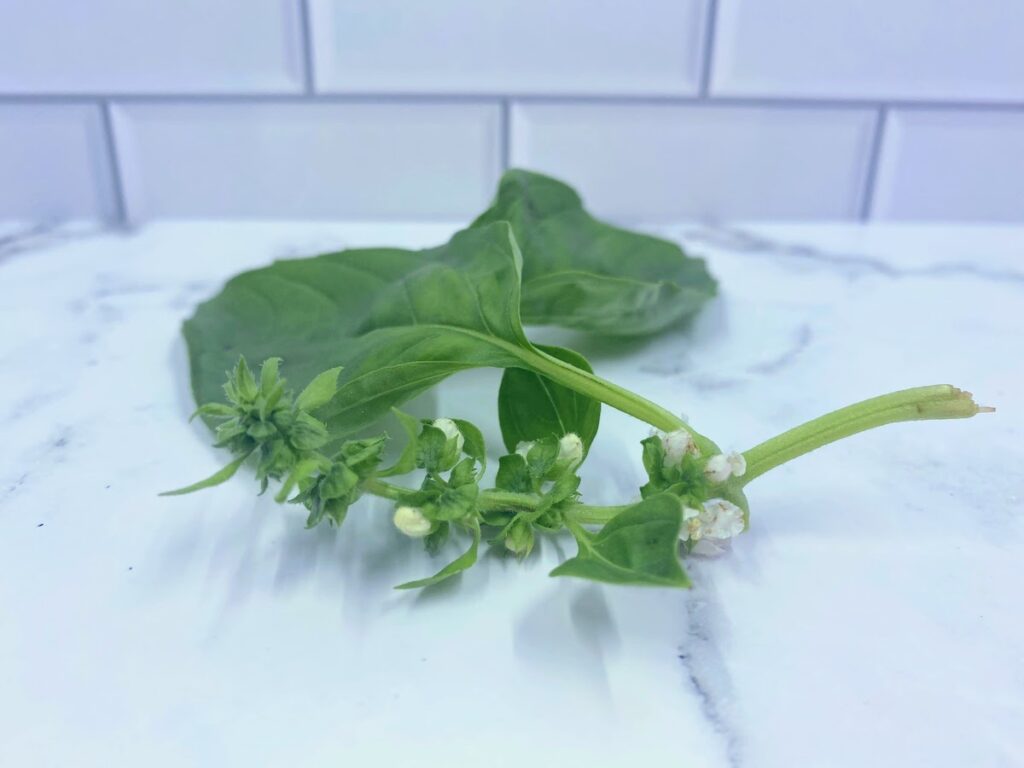
If you want both the leaves and flowers basil produces, you can grow a series of plants, all at different stages of the growing cycle, about 1 to 2 weeks apart is ideal. This way, you’ll have plenty of leaves, as well as some lovely flowers throughout the season.
Can You Eat Basil Flowers, or Basil Leaves After the Plant Flowering?
Yes! Basil flowers are safe to eat, and taste like young leaves, only milder. Toss them in salads, or throw them on top of a meal you’d typically use leaves in as a garnish. You can also use them when making pesto.
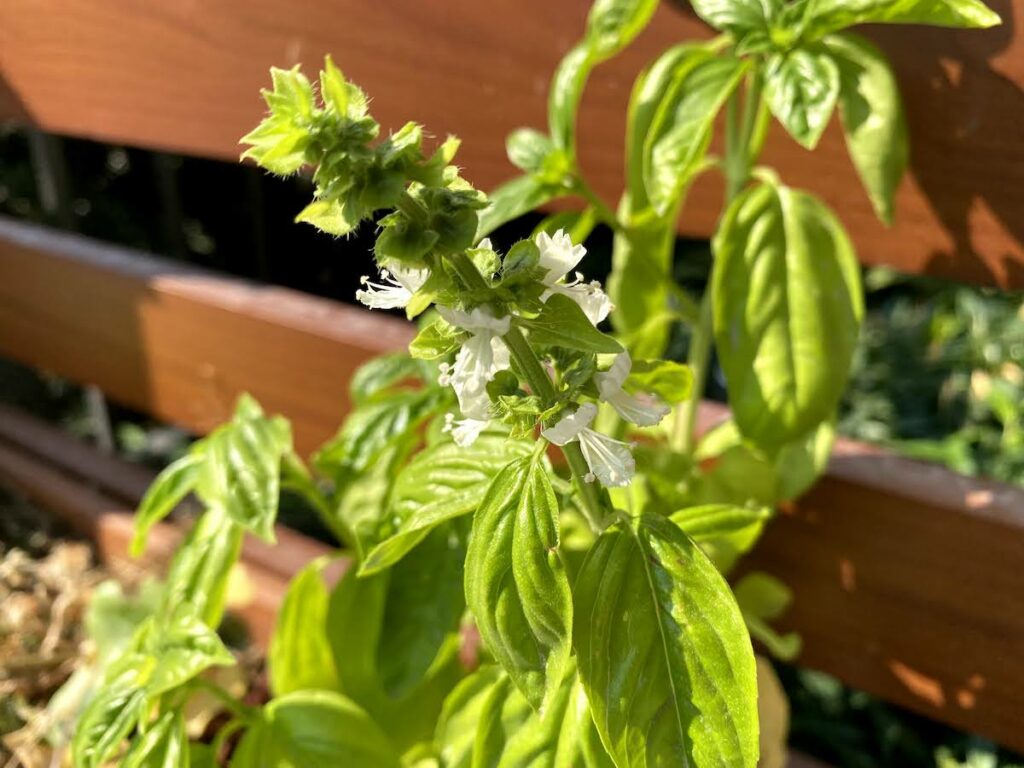
After flowering, the leaves are also safe to eat, although they’re not as delicious as pre-flowered basil leaves are. Sometimes, they’re milder, but you may also find them to be tougher and more bitter than the tender, fragrant leaves of a younger plant. Leaves may even wilt a bit after flowering, signalling they are near the end of the basil lifecycle.
- Sprinkle or toss in a salad or pasta dish
- Boil with water to make basil flower tea
- Serve as a garnish on a cheese and charcuterie platter
- Use them to make a batch of basil flower vinegar or basil flower olive oil (basically, infuse clean dry basil flowers in red or white wine vinegar or olive oil for 2 weeks to a month, then strain and remove for flavored vinegar or oil).

How to Prevent Basil Flowering
They key to preventing basil flowers is regularly pruning your basil.
Pruning sends a magic message to your basil that it’s not time to flower yet, so please keep making delicious new leaves.
As a general rule, I prune my basil every one to two weeks or so, or when the plant reaches around 8 inches high (the maximum you want it to reach). Keep an eye on the plant’s size in general as well, and move it to a bigger pot if you’re container gardening and it appears to be outgrowing it’s current pot!
Prune from the top, which lets more sunlight reach the leaves below, and stimulates more leave growth and a healthier, bushier plant full of delicious leaves.
If you haven’t pruned fro a while you’ll notice the leaves at the top of the plant are really small – those are actually flowerettes, and pruning them off will really encourage more plant growth.
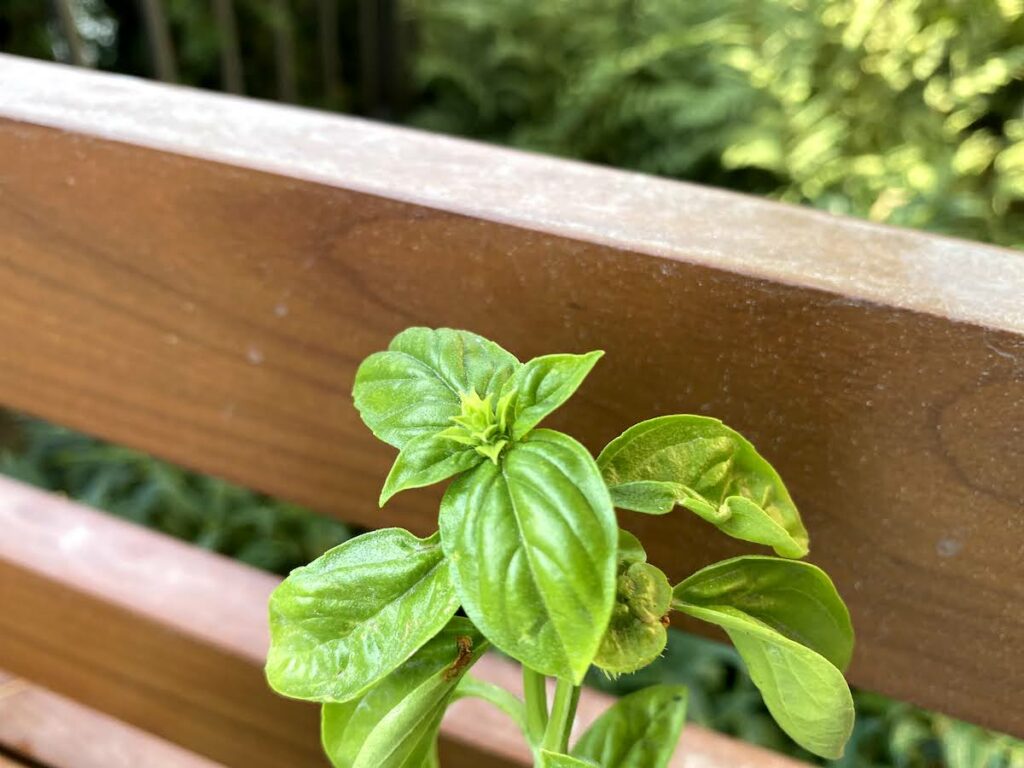
Pruning your basil doesn’t have to feel like a chore – simply pinch near the stem, and grab at least the two top leaves on each stem. Then use them to cook, of course!
As with watering your basil, it’s best to prune in the morning. The leaves are in the best condition before the heat of the day, with the strongest concentration of the aromatic oils.
Of course, remove any damaged leaves while you’re at it. This includes basil leaves that appear to have been munched on, brown spots, white patches or spots, black spots, yellowing of specific leaves, or anything that is obviously dead or rotting.
What To Do With Basil Flowering When You Don’t Want it To?
If you notice one or two flowers on your basil, don’t lose all hope.
Simply grab a pair of garden shears and cut them off. This will signal to the plant that it’s time to keep directly energy into leaves, not flowers.
If it does go to seed, save the seeds to plant in your garden next year. You’ll want to sow the seeds in the late spring, ideally indoors, before transplanting the seedlings outside once the soil has warmed up.
Summary And What To Try If Your Basil Plant is Flowering?
- Basil flowers when its not pruned regularly, so make sure you prune every two weeks, or once your plant reaches 8 inches tall
- To prune a basil plant, pinch the leaves at the top, removing at least the two top leaves from each stem
- Once your plant flowers, it will also seed, and the quality of leaves it produces will no longer be of the best quality or taste for using in the kitchen
- The flowers are edible, and have a milder taste than the leaves, so feel free to add them into your recipes and experiment a bit, if you have them!
